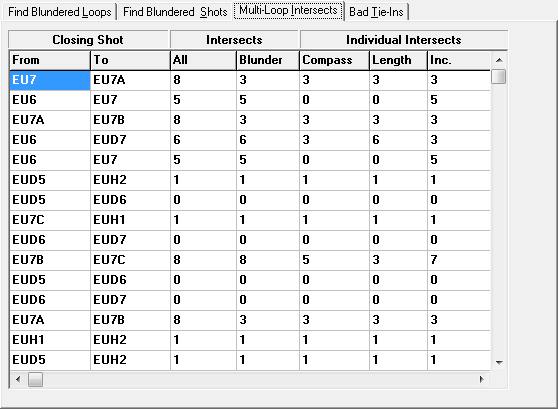When you are looking for blunders, there are often several shots that are good candidates for blunders. The "Intersect" method is a way to help you zero in on the exact shot that has caused the blunder. It works like this: if you have a blundered shot that is part of two loops, then it should show up as a good blunder candidate in both loops. If the shot shows as a good blunder candidate in one, but not in the other, it is very unlikely that the shot is a blunder. When a blunder shows up as a good candidate in two loops, this is called an "intersect." The more loops that appear to be blundered by a particular shot, the more likely that shot is the blunder.

When Compass analyzes a loop, it automatically looks at all other loops in the cave to see if any of the shots in the current loop also appear in other loops. It then analyzes these loops to see if it is a blunder candidate in those loops. To view a list of “Intersect,” simply select the “Multi-Loop Intersects” page.
The program displays a list of each intersect and detailed information about the intersect. Here is a description of each item:
1. From-To. As before, these two items specify the closing shot of the loop.
2. Intersects - All. This item displays a count of all the loops that this shot appears in. This is maximum number of intersects possible. If this number is zero, the shot does not appear in any other loops and you cannot tell one way or the other whether the shot is a good candidate.
3. Intersects - Blunder. This item displays a count of all the loops where this shot appears as a blunder. This number can be anything from zero to up to the total number of intersects. The larger the number, the more likely the shot is the actual blunder. The most likely blunder candidates will appear to be blundered in most of the loops they are a part of.
4. Individual Intersect Items. This section analyzes the individual measurements in a potentially blundered shot and show which measurements appear to be blundered in other loops. The item shows compass, tape and inclination and the number of times each appears blundered. The total of these numbers can be greater than the number of blunder intersects, because a single shot can have more than one measurement that appears to be blundered. For example, a single shot could appear to have the compass, tape and inclination blundered.